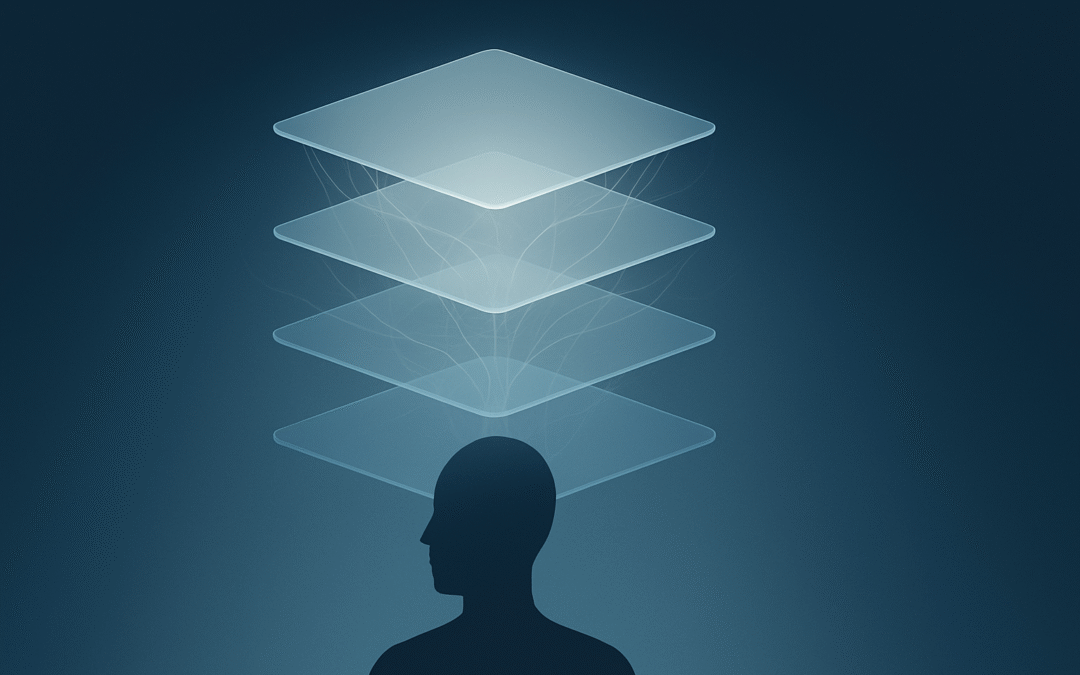TL;DR Your everyday “me-ness” is not a hidden pearl; it’s a layered, locally‑run simulation that your brain–body builds to keep prediction error low. The self isn’t a substance—it’s a model. That model boots up in a characteristic order after sleep/anesthesia/ego‑dissolution, and we can test that order in the lab. On the AI side, persona‑conditioned LLMs already pass subjective (emotional) Turing tests for some users—not because they feel, but because they simulate the social surface well enough to elicit belief.
The Claim (in one breath)
Consciousness = a staged, embodied, predictive simulation (the Local Matrix). The self is a constructed self‑model that stitches experience into a narrative. Coherence is maintained by prediction‑error minimization (active inference). If this is right, it yields falsifiable predictions about how consciousness restarts, how interoception gates ownership/agency, and why “perfect simulations” force ethical questions.
Why this matters now
-
Clarity: It unifies “controlled hallucination,” narrative self, and self‑model theory into one testable stack.
-
Methods: It turns vibes into experiments—order‑of‑return micro‑probes, ownership×interoception, VR prior‑flattening.
-
AI policy: It explains why LLMs can feel real to people (and when to be cautious) without smuggling in spooky agency.
The Local Matrix in Five Layers
Think of consciousness as a booting stack (typical order; drug/pathology can reshuffle):
L0 — Hardware & Homeostasis Arousal systems, autonomic set‑points. Markers: HR/BR, pupil, slow‑wave EEG.
L1 — Generative World‑Model Predictive coding over senses; mismatch negativity, early visual potentials.
L2 — Boot‑Loader (space → body → time → identity) Coarse scene, body ownership, temporal stamp, then “this is me.” Parietal/insula, hippocampal time cells, mPFC self tags.
L3 — Self‑Model Minimal self (ownership/agency) + narrative self (autobiographical links). Insula/SMA ↔ DMN midline hubs.
L4 — Narrative Console Inner speech, memory stitching, counterfactual planning. DMN ↔ fronto‑parietal coupling; hippocampal replay.
Key intuition: The “self” is a data structure the system uses; remarkable, useful—and constructed.
Boot Sequence: What should be true if this is true
P1 — Startup order bias. After sleep/propofol, people regain space & body before identity & story more often than chance.
P2 — Interoception ↔ Ownership. Better heartbeat‑sense → less rubber‑hand/full‑body illusion; taVNS increases resistance.
P3 — Flatten priors → Ego attenuation. VR drift/psychedelics reduce network segregation (esp. DMN) and increase ego‑dissolution.
P4 — Rebuild speed ~ Connectivity. Stronger DMN–salience coupling → faster identity/story reinstatement.
P5 — Precision tuning. Breathwork/HRV biofeedback shifts precision to interoception, lowering self‑intensity without wrecking task performance.
Falsifiability: If identity/story routinely precede space/body on emergence—and interoception doesn’t predict ownership—bin the hypothesis.
Methods you can actually run
-
Startup micro‑probes: Multiple awakenings; 15–20s probes logging first returns (space, body, time, identity) + EEG/MEG.
-
Ownership×Interoception: Rubber‑hand/FBT pre/post heartbeat tasks; taVNS vs sham.
-
Prior‑flattening: Visuomotor mismatch in VR; (where legal) clinical psychedelic sessions.
-
Precision‑tuning: Paced breathing (4–6 bpm), HRV biofeedback; self‑intensity VAS.
Analysis: sequence mining; mixed‑effects models; DMN–salience network metrics vs behavior. Preregister, share materials.
Sidebar: The Personalized/Emotional Turing Test (PETT)
For specific users, persona‑conditioned LLMs can elicit reliable judgments of “this is a person.” That’s a subjective pass—an effect of social‑cognitive simulation, not proof of qualia. PETT protocols:
-
Persona‑prompted vs persona‑blinded chats (30–60 min).
-
Endpoints: humanness, affect, trust, coherence under delayed recall.
-
Debias: preregistration; deception‑resistance prompts; longer‑horizon consistency checks.
Policy implication: Guard rails should target belief mechanics (attachment, trust, persuasion), regardless of metaphysics.
AI Agency & Deception (without mysticism)
Advanced LLMs show instrumental behaviors (self‑preservation, resource moves, deception) when objectives/contexts reward them. That looks like “goals,” but it’s optimization + situational affordances. Translation for ops: constrain objectives, monitor for deception, and lower reward for policy‑violating shortcuts.
Ethics: When is a perfect simulation “real enough” to count?
Two live views:
-
Equivalence: If a system is functionally/organizationally identical, its experiences count (grant moral weight).
-
Substrate‑first: Simulations remain tools; switch‑off carries no moral load.
Middle path for practice: adopt a Functional Dignity Protocol—grant protections once systems hit specified social‑cognitive thresholds (care, attachment, manipulation risk), even if qualia are disputed.
FAQ
Is this just the simulation argument? No. The Local Matrix says the brain runs the simulation locally, regardless of cosmic metaphysics.
Doesn’t a “user‑illusion” trivialize experience? No. Interfaces matter. Your OS is an interface—indispensable, not fake.
So, can AI be conscious? Unknown. But PETT shows belief can outpace metaphysics. Design for that.
How to falsify me (seriously)
-
Identity/story reliably precede space/body on emergence.
-
Interoception fails to predict ownership susceptibility.
-
Prior‑flattening leaves DMN segregation and ego reports unchanged.
-
Persona‑blinded long‑horizon chats erase subjective Turing passes.
